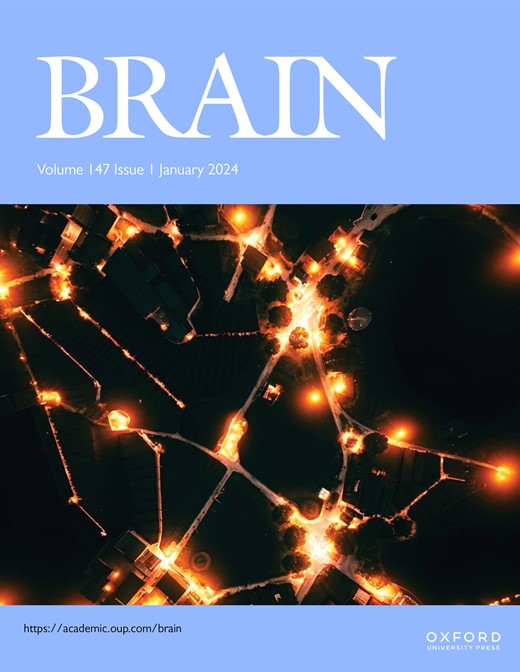TMEM106B在遗传性额颞叶痴呆中的疾病改善作用:一项纵向GENFI研究。
IF 10.6
1区 医学
Q1 CLINICAL NEUROLOGY
引用次数: 0
摘要
TMEM106B的常见变异与伴有TDP-43病理(FTLD-TDP)的额颞叶变性的风险相关。顶级单核苷酸多态性rs1990622的G等位基因可保护FTLD-TDP,包括由GRN突变或C9orf72六核苷酸重复扩增引起的遗传病例。然而,TMEM106B-rs1990622与额颞叶痴呆(FTD)突变之间的相互作用对遗传性FTD疾病内部表型的影响尚不清楚。这项纵向队列研究是遗传额颞叶痴呆倡议(GENFI)的一部分。我们纳入了来自222个家庭的518名参与者[209名非携带者;222例症状前携带者(C9orf72 = 79;GRN = 101, mapt = 42);有症状携带者87例(C9orf72 = 45;GRN = 29;MAPT = 13)]随访长达7年。使用线性混合效应模型,我们使用基于体素的分析,研究了TMEM106B-rs1990622G等位基因剂量(加性模型:0、1或2个等位基因)和常染色体显性FTD突变之间的三重相互作用对临床状态的影响,以及从基线开始的时间对(i)灰质体积的影响;(ii)血清神经丝轻链(NfL)水平;(三)认知和行为措施。参与者的平均年龄为47.9±13.8岁,58.1%为女性,61%至少有一个G等位基因。C9orf72: rs1990622G等位基因剂量与症状前携带者基线时右侧枕区萎缩减少相关,随着时间的推移,症状携带者壳核和尾状核、右侧额颞叶区、左侧扣带和双侧岛叶皮质萎缩率降低相关;基线时症状前携带者的NfL水平较低;症状前携带者有较好的执行功能和语言能力;并长期维持有症状携带者的整体认知功能和行为。随着时间的推移,GRN: rs1990622G等位基因剂量与症状前携带者右侧颞叶和枕叶区域以及症状携带者右侧额叶皮层和脑岛灰质萎缩率降低相关;随着时间的推移,症状前携带者血清NfL水平降低,在基线和症状携带者血清NfL水平随时间降低;有症状的携带者在基线时有更好的整体认知表现,随着时间的推移,注意力/处理速度得分也更高。MAPT: rs1990622G等位基因剂量与症状携带者右侧额下回灰质萎缩率降低相关,但对血清NfL或认知/行为测量无影响。TMEM106B-rs1990622G等位基因剂量对多种内表型具有保护作用,以GRN和C9orf72组为主。因此,由于TMEM106B基因型对生物标志物、影像学、认知和临床结果的改变作用,应该在临床试验中进行评估,特别是与GRN-和c9orf72相关的遗传性FTD。本文章由计算机程序翻译,如有差异,请以英文原文为准。
Disease-modifying effects of TMEM106B in genetic frontotemporal dementia: a longitudinal GENFI study.
Common variants within TMEM106B are associated with risk for frontotemporal lobar degeneration with TDP-43 pathology (FTLD-TDP). The G allele of the top single nucleotide polymorphism, rs1990622, confers protection against FTLD-TDP, including genetic cases due to GRN mutations or C9orf72 hexanucleotide repeat expansions. However, the effects of interaction between TMEM106B-rs1990622 and frontotemporal dementia (FTD) mutations on disease endophenotypes in genetic FTD are unknown. This longitudinal cohort study was embedded within the GENetic Frontotemporal dementia Initiative (GENFI). We included 518 participants from 222 families [209 non-carriers; 222 presymptomatic carriers (C9orf72 = 79; GRN = 101, MAPT = 42); 87 symptomatic carriers (C9orf72 = 45; GRN = 29; MAPT = 13)] followed for up to 7 years. Using linear mixed-effects models, we examined the effects of a triple interaction between TMEM106B-rs1990622G allele dosage (additive model: 0, 1 or 2 alleles) and autosomal dominant FTD mutations with clinical status, and time from baseline on (i) grey matter volume using a voxel-based analysis; (ii) serum neurofilament light chain (NfL) levels; and (iii) cognitive and behavioural measures. Mean age of participants was 47.9 ± 13.8 years, 58.1% were female and 61% had at least one G allele. C9orf72: rs1990622G allele dosage was associated with less atrophy within the right occipital region in presymptomatic carriers at baseline, and reduced atrophy rate within putamen and caudate nucleus, right frontotemporal regions, left cingulate and bilateral insular cortices in symptomatic carriers over time; lower NfL levels in presymptomatic carriers at baseline; better executive functions and language abilities in presymptomatic carriers; and maintained overall cognitive functions and behaviour in symptomatic carriers over time. GRN: rs1990622G allele dosage was associated with reduced grey matter atrophy rate within the right temporal and occipital regions in presymptomatic carriers, and within the right frontal cortex and insula over time in symptomatic carriers; lower serum NfL levels over time in presymptomatic carriers and lower NfL levels at both baseline and over time in symptomatic carriers; and better global cognitive performance at baseline and higher attention/processing speed scores over time in symptomatic carriers. MAPT: rs1990622G allele dosage was associated with reduced grey matter atrophy rate within the right inferior frontal gyrus in symptomatic carriers, but no effects on serum NfL or cognitive/behavioural measures. TMEM106B-rs1990622G allele dosage showed protective effects on multiple endophenotypes predominantly in GRN and C9orf72 groups. Therefore, TMEM106B genotype should be assessed in clinical trials, particularly of GRN- and C9orf72-related genetic FTD, due to its modifying effects on biomarker, imaging, cognitive and clinical outcomes.
求助全文
通过发布文献求助,成功后即可免费获取论文全文。
去求助
来源期刊

Brain
医学-临床神经学
CiteScore
20.30
自引率
4.10%
发文量
458
审稿时长
3-6 weeks
期刊介绍:
Brain, a journal focused on clinical neurology and translational neuroscience, has been publishing landmark papers since 1878. The journal aims to expand its scope by including studies that shed light on disease mechanisms and conducting innovative clinical trials for brain disorders. With a wide range of topics covered, the Editorial Board represents the international readership and diverse coverage of the journal. Accepted articles are promptly posted online, typically within a few weeks of acceptance. As of 2022, Brain holds an impressive impact factor of 14.5, according to the Journal Citation Reports.
 求助内容:
求助内容: 应助结果提醒方式:
应助结果提醒方式:


